How shocked would you be if I told you that a few minor adjustments to your Amazon KDP keywords could instantaneously catapult your book from a Best Seller Ranking (BSR) in the hundreds of thousands to a BSR in the tens of thousands in the Amazon KDP bookstore?
Well, it can. For a new author who doesn’t have an established audience, you need to take advantage of your Kindle keywords if you want to find readers other than your family members on an online book store like Amazon with millions of other books.
In this article, we will explain how Amazon Keywords work, and how to find and pick the best keywords to help you sell more books which raises your books higher in the best seller ranking and helps you sell more books.
How do Amazon KDP keywords work?
Amazon KDP keywords are specific terms or phrases that readers search for when they want to read certain types of books.
Your kindle keywords tell Amazon that if someone types an exact keyword term or phrase, you want Amazon to send them to your book.
For example, to get to this article, you searched for a keyword phrase/question like “How do I find good keywords for Amazon KDP?”. A reader, on the other hand, would use Amazon’s powerful search engine to search for “Clean and wholesome young adult romance” to find fiction books whose content fit that keyword phrase.
As an author, you want to use Kindle keywords that are regularly searched for so that your book has more chances of appearing in front of readers. But you don’t want to use the wrong keywords either.
How many keywords can you use on KDP?
Whenever an author publishes their book via Amazon KDP, they are given seven spaces or Kindle keyword boxes where they can add keyword terms or phrases which they want readers to find their book using.
Your seven Amazon Keywords along with your book’s metadata such as its title, author name, book description, etc. help Amazon’s algorithm present your book to the people you have identified as your target readers.

Here are a few more things you should know about Amazon KDP keywords:
- Amazon allows authors to include keyword phrases up to 50 characters long in each of the seven keyword boxes. This means you can fit as many words as you can as long as they’re not beyond 50 characters and sound reasonable as a keyword phrase.
- Amazon could rearrange the words in each keyword box for you in many, and some would say, every possible combination so your book can rank on more search result listings.
- Amazon KDP’s algorithm includes your book in the search results listings for both singular and plural versions of your keywords automatically.
- Amazon has spoken and unspoken rules regarding the use of its keywords.
I’ll address the unspoken rules in the Keywords Best Practices part of this article but some of the spoken rules are:
- Don’t use another Author’s name as a keyword phrase
- Don’t use subjective claims keywords like ‘Awesome novel’ or ‘best novel ever’.
- Don’t use time-sensitive statements like ‘new’, ‘available now’ or ‘on sale’.
- Don’t use Amazon program names like ‘Kindle Unlimited’ or ‘KDP Select’ in your keywords.
Why Amazon KDP Keyword Research is Important?
Before we go into how you can find the best keywords, let’s talk about some of the not-so-obvious benefits of carefully selecting your book’s Amazon KDP keywords other than, of course, increased sales.
- Kindle keywords can get your book into SPECIAL Amazon KDP book categories. You cannot add your book to certain book or kindle categories on Amazon because they’re only available if you have specific keywords attached to your book.
- Amazon KDP Keywords combined with your book’s metadata will get your books to show up higher in your target reader’s relevant search results. This means that with Kindle keywords, you can make your book accessible to readers who are searching for them.
- If you pick the right Amazon keywords that fit your book’s content, Amazon’s algorithm will not only display your books higher for the keywords’ search results, but they will also display your books on related keyword terms and phrases.
How to find the best keywords for your Amazon KDP book
STEP 1: Make a list of possible keywords
The first step to finding good keywords for your Amazon books is with a short brainstorming session to create a list of possible keywords that your target readers might be interested in.
For fiction, you’re creating a list with details from your book such as:
- Tropes like Werewolf mates, enemies to lovers, etc.
- Settings like Chicago, paranormal world, fantasy world, the English countryside, etc.
- Character roles like male lead with harem, the badass female lead, etc.
- Character types like young adult, single father, divorced woman, etc.
- Plot themes like weak to strong, self-discovery, character growth, etc.
- Story elements like clean and wholesome romance, spicy romance, hate-love relationship, etc.
For non-fiction authors, you’re building a list of KDP keywords using:
- The pain points your book addresses. Eg. how to sleep well at night, how to end insomnia, etc.
- Your target reader’s behaviors, concerns, interests, etc. related to your book. E.g. Restless insomniac remedies
- The solution or benefits your target reader stands to gain by reading your book. E.g. Sleep better with meditation.
STEP 1.5: Use the Category Sidebars
If you cannot think of keywords based on tropes, genre, categories, character types, etc., then you can use Amazon’s helpful category sidebar.
This is an example of the sidebar for the Science Fiction & Fantasy > Fantasy category:
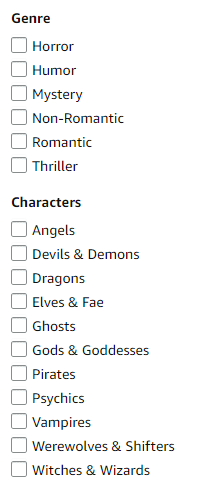
And another from the Romance Category:
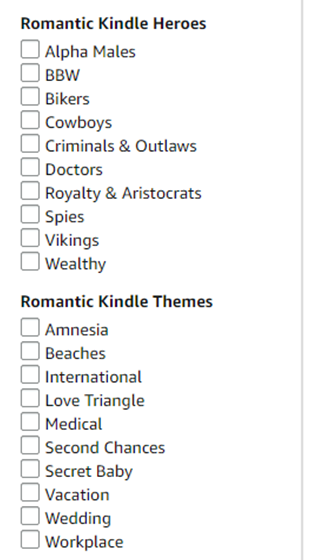
If you strategically use the keywords of these sidebar tick categories, you may be able to get into the sidebar categories.
STEP 2: Research with Amazon’s Autocomplete Search Function
Once you have built a list of keywords related to your book, you need to visit Amazon and use its autocomplete search function to confirm that your readers are actually searching for those keyword terms or phrases you wrote down off the top of your head earlier.
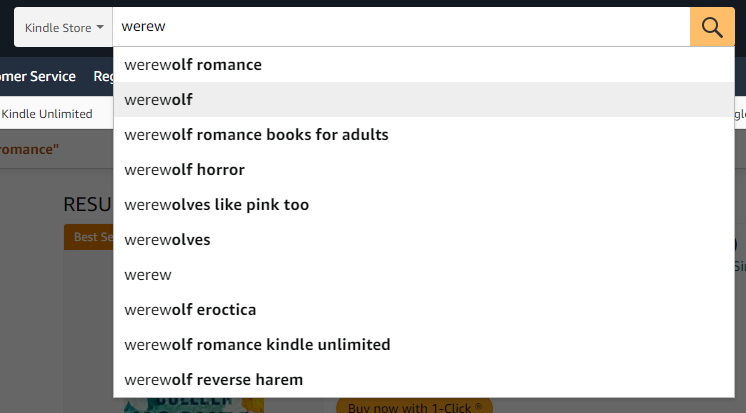
It’s best to do this research in incognito mode or private mode so that Amazon’s algorithms will not use your book preferences to color the results of your searches which is what happens to every reader searching for books.
In the Amazon search box, you start typing word by word every keyword term or phrase in the list of keywords you wrote down in step one. When Amazon suggests certain parts of the phrases or the full phrase, you need to create a new list of that and the related phrases that Amazon suggests because you’ve just started building your real list of Amazon KDP keywords that your target readers are searching for.
STEP 3: Use Amazon KDP Keyword Research Tools
There are certain free tools that can give you more information or give you access to more keywords free of charge. Some of those tools are: AMZ Suggestion Expander, the DS Amazon Quick View, and the SelfPublishing Titan’s Amazon Keyword Research Tool Google Chrome Extensions.
With these tools, you can find more possible keywords and validate them.
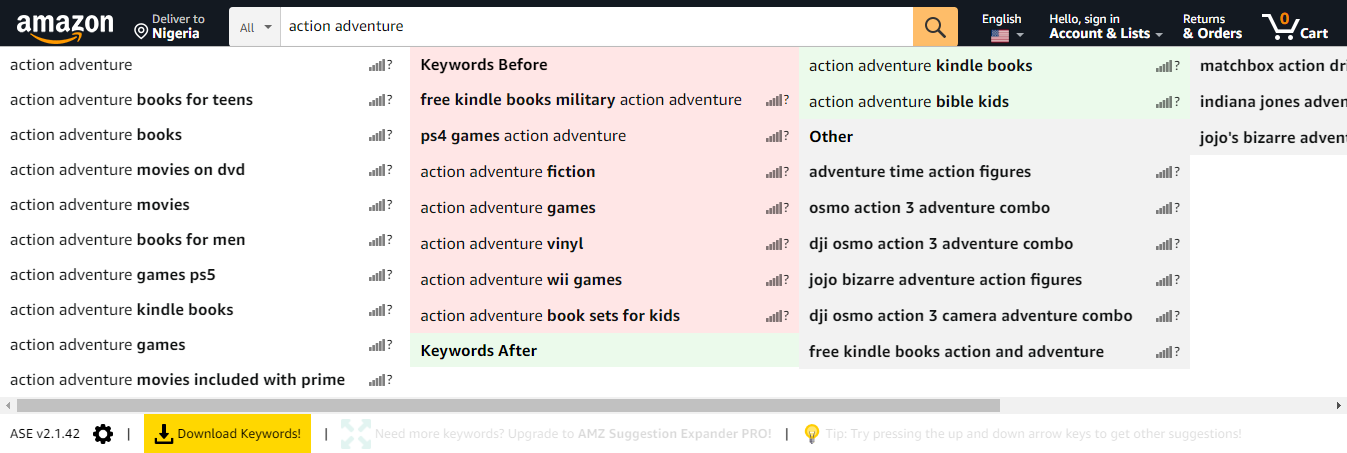
STEP 4: Select the Best Keywords for your Book
Now that you have a long list of keywords, you need to verify their viability. Here, the questions you need to ask are: Does this keyword have many readers searching every month? How competitive is this keyword?
If you’re willing to pay to have access to data about the viability of your Amazon keywords, you can skip to Step 5. If not, read on to learn some techniques for free Amazon Keyword research.
One technique is to use your gut feeling and time-intensive research to choose the best keywords. In this case, you will need these free Amazon Keyword research tools: DS Amazon Quick View and the SelfPublishing Titan’s Tool.
The DS Amazon Quick View tool will give you information on the Best Seller Ranking of the books at the top of the search listings. Keyword terms or phrases whose top ten results have good Best Seller Rankings should be deemed more viable.

But you need to remember that keywords are not the only things that sell books on Amazon so using this method also has risks. And that viable keyword may also be too competitive.
Another method is using the SelfPublishing Titan’s Amazon Keyword Research Tool.

With this, you can gauge the competitiveness of a keyword on a score of 0 to 100 provided by SelfPublishing Titans. You can take this tutorial to learn how to use this tool better.
STEP 5: Select the Best Keywords for your Book using Publisher Rocket (Optional)
You can skip steps 2-4 using Publisher Rocket which is why it is a very time-friendly tool for authors.
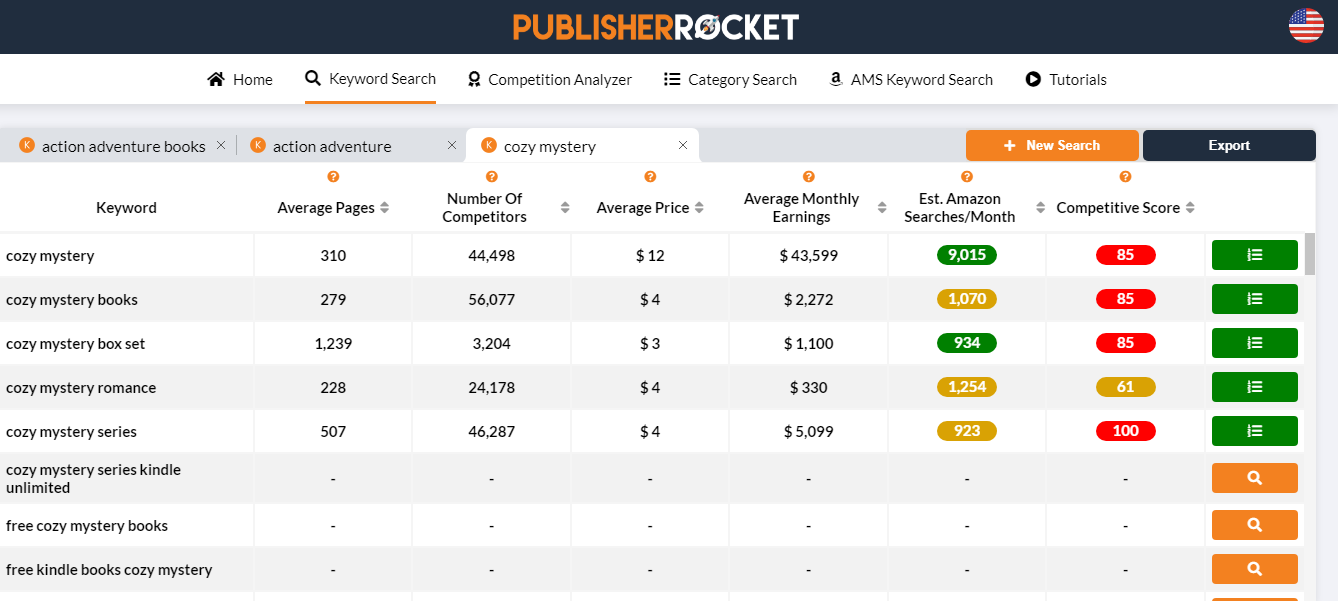
Once you have a basic list of keywords, all you have to do is go to Publisher Rocket, also known as, KDP Rocket and start harvesting relevant keywords based on actual data.
With Publisher Rocket, you have access to Amazon KDP keyword information like:
- The number of competitors using a particular keyword.
- The average price of books using that keyword.
- The average monthly earnings for books using the keyword.
- An estimate of Amazon monthly searches for your keywords accompanied by three colors that show whether the searches are viable or not.
- A competitive score from 0 to 100 that shows whether that keyword is too competitive or if you can compete with your book.
- The book categories that competitors using those keywords are in.
- An analysis of how much books using that keyword earn daily and monthly.
You also have access to features like:
- Category Research Tools
- Amazon Ads Keyword Research Tools
- A Competition Analyzer Tool.
Learn how to use this tool with my Publisher Rocket review article.
Pros
- You pick keywords with Publisher Rocket based on important data like how many searches a keyword gets monthly, how competitive a keyword is, etc.
- You can analyze competitors using the keywords you want to choose.
- You can check how much the top sellers in certain keywords are making monthly.
- A one-time payment software ($97), not a monthly/annual subscription with free updates forever.
- You have almost accurate data on Amazon books, ebooks, and audiobook keywords and categories.
- Saves time that you would have spent trying to determine the best viable keywords without data.
Cons
- No free trial to give you a chance to test out the keywords.
- Only Amazon KDP US, UK, and DE (German) marketplace data are available.
- PC and Macs only software. No Linux.
Amazon KDP Keywords Best Practices: How to use Kindle Keywords
Based on Kindlepreneur’s Kindle Keyword research and some of my personal research using my books’ data, here are some Amazon KDP keyword best practices to follow:
- Use Long-tail keywords, that is, keyword phrases with multiple terms in them. E.g. Rejected fated mate, young adult paranormal romance, etc.
- Do not use Quotation marks with your keywords. Using them stops the Amazon algorithm from indexing your book for other KDP keyword variants or combinations.
- Monitor your book performance to see if your keywords are successful. You can also change and try new keywords every few months. While trying new keywords, remember to record the increase or decrease in book sales.
- Put your best and most viable keywords in your title and subtitle because you’ll get a higher ranking on the Amazon search results than someone who only has the keyword in their KDP keyword boxes.
- Do not use keywords that have nothing to do with your book. If you do that, your book may not get indexed for those keywords because Amazon uses your book’s metadata to determine if your keywords are relevant or not.
- Using the Same keywords twice does not help your book rank higher in Amazon search result pages. But it also doesn’t hurt your book.
- Amazon can rearrange the words you put in your keyword box and index your book for them if they think it is legitimate. E.g. for the fake keyword, angel and demon fantasy romance, Amazon could index your book for: angel fantasy romance, angel demon romance, angel demon fantasy, etc.
- Reasonably filling all 50-character keyword terms and phrases that Amazon allows you to put in each keyword box increases the number of keywords your book is indexed for.
- While it is true that people say you can use Google SEO tools and google indexed keywords for your Amazon keywords, I don’t recommend it.People searching on Amazon are ready to make a purchase, people searching on Google may have other purposes. That is why I recommend focusing on getting the best keywords for Amazon using Amazon keyword research tools.If you want to help your book rank higher on Google search engine result pages, you can use Google Keyword Research tools. Of course, you can also look out for Google SEO tools that collect Amazon Keyword data like Keywordtool.io and Ahrefs.
- Do not use misleading keywords. If you do that, you won’t be able to meet your reader’s expectations which could produce two results:
Bad Result 1: The reader buys the book but while the keyword your book showed up for was ‘clean and wholesome romance’, your book has many sex scenes or spicy scenes so your reader gives it a bad review.
Bad Result 2: The reader finds your book in that listing produced by searching for that keyword phrase and is interested in it based on the cover. Then he or she reads the book description and discovers that the book is entirely different from what he or she wanted based on the keyword you put on the book. The reader then clicks out, refusing to buy the book.
As this happens with more and more readers, your book will be shown to fewer readers searching for that keyword.
Although there is a possibility of a good result where the reader finds your book with an inappropriate keyword and ends up liking it, it is very dangerous to base your book’s Best Seller Ranking based on assumptions when you can pick better keywords that readers looking for the things in your book are actually looking for.
Final Thoughts
Regardless of whether you want to use a paid tool or do free Amazon KDP keyword research, do not skip doing the necessary Kindle keyword research for the keywords you want your book to rank for.
Other than ads, your best chance at organic sales and a better Amazon Best Seller Ranking will always be your book’s metadata and your Amazon KDP keywords. So take your keywords seriously.
You can buy Publisher Rocket here. I promise that, based on my personal experience, it is worth every penny.









